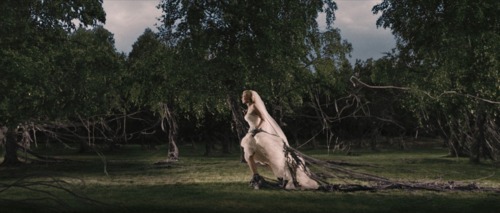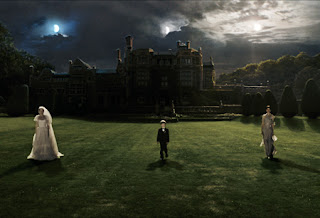
Denmark auteur Lars von Trier’s latest film, Melancholia, begins with a poetic overture filled with images that foreshadow what is to come at the end of the film. The breathtaking mis-en-scene photographed by Manuel Claro captures an austere Victorian air starting with a lavish wedding and ending with the end of the world, literally. Von Trier takes us through the rapidly unraveling world of Justine who, it would seem, battles a crippling case of depression, although it’s not all together clear why she’s so upset. Played by Kristen Dunst, Justine is very good at faking happiness but soon spirals into palpable misery. Alexander Skarsgard plays the groom with only a few lines and departs half way through the film due Justine’s lack of faithfulness and faith in general. The rest of the story follows Justine and her sister’s family (sister adeptly played by Charlotte Gainsbourg) as they count down the days as the blue planet Melancholia plummets towards earth.
Von Trier’s creation starts with a visually stunning overture. The beginning opens with a slowly cranked montage of scenes set to Wagner’s operatic score Tristan and Isolde. Images of Justine laid out as Ophelia in her wedding dress floating in a river are paired with the perfectly laid out gardens of the family estate, an homage perhaps to Alain Resnais’ Last Year at Marienbad (1961). This immediately creates a juxtaposition of nature and civilization laying the thematic foundation. Von Trier’s camera focuses in and out, blurring the people around the room creating a documentary feel to the film. He also uses a highly intrusive camera with extreme close-ups during conversations between various characters. The overture includes planets moving like Kubrick’s 2001 – a bit tired after already sitting through 3 hours of Terrance Malick’s Tree of Lifeearlier this year. The camera lingers on the solar system, floating, and then cuts to various characters standing in the garden also aligned like planets. Again von Trier visually establishes the nature/civilization dichotomy.
Throughout the film we see confrontation between the characters and the natural world – the archetypal struggle between man and nature. Claire’s husband John (Keifer Sutherland) is obsessed with watching the planet rise and pass by Earth, and he swears that everyone will be safe. As the planet draws near, John doubts their safety, abandons his family, and commits suicide, panicking in the face of doom. On the other hand, the sisters bravely confront the impending end of the world. Von Trier’s story illustrates how each person deals with their reality in different ways. The narrative set up of the film is 2 acts – Justine’s and Claire’s – that mirror Wagner’s operatic score. We see the hysteria transfer from Justine to Claire as the point of narrator changes. Justine is stunted by her depression and cannot even get into the bath, but when death approaches, she is calm. Claire, on the other hand, has everything in control, until she cannot change what is going to happen – she cannot stop the planet from coming. She clutches her son as the hail hammers down, and there is nowhere for her to run. Nature is uncontrollable; even the cars won’t start.
The film as a whole is broken into two parts: the wedding reception and then sometime later when the planet is about to hit Earth. The first half is the society and institutions that we as humans have created which are thrown away in the face of death. There are slow images of Justine in her wedding dress running as roots attempt to pull her down. The second part conveys the true nature of all the characters. Justine stays calm and faces her fear; Claire lets herself be emotional and fight for her child’s life; and John, the coward, gives up out of fear. It is as if nature will eventually show the true “human nature” of us all.
For auteurists and cinephiles alike, this film is worth seeing and a nice respite from von Trier’s other works that involve over the top violence. On a side note, watch closely: the images at the beginning of the film are only semi-complete. Later in the film, the images are different, as von Trier fills in the rest of the scene, particularly the rider-less horse.
For more reviews visit My State of Film

